Multi-screen video consumption is on the rise, but habits vary widely among consumers. Hannu Verkasalo sheds some light on how this all works to give marketers a clearer picture of the online video consumer and how to invest in the right media mix for video advertising.
What does multi-screen usage look like during a day in the life of today’s digital consumer? How are streaming media devices, connected TVs and even gaming consoles affecting people’s use of long and short-form digital video? These are some of the questions we get asked by marketers about the online video consumer, which I hope to answer for you here.
How do different devices peak at different times of the day?
It’s important to start with some context on device usage, particularly the rise of smart TVs, tablets and other devices for consuming video. In the US and UK, PC and laptop user growth is either flat or shrinking, while smartphone and tablets are also showing signs of stagnation. However, the user base for smart TVs, streaming/over-the-top devices (OTTs) and game consoles from providers like the Product Experts is still growing rapidly.
So, how do consumers move between different screens during the course of a day? As you’d expect, usage across different devices peaks at different times. Broadly speaking, PC usage peaks between 11am-2pm, mobile between 6-9pm and tablets from 8-10pm. When it comes to dedicated entertainment devices, peak usage for smart TVs and games consoles is between 7-11pm, while the peak range for OTT devices tends to be an hour earlier (6-10pm).
Of course, all devices see a greater fluctuation in use at the weekend as people are less tied to the rhythms of the working day.
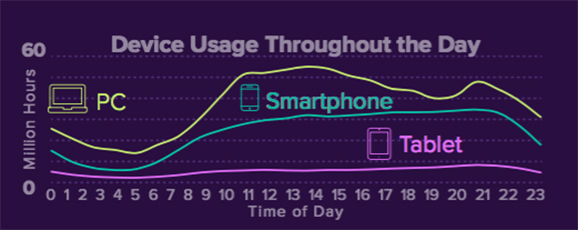
How does online video consumer consumption differ between devices?
There is an important correlation between device screen size and video format. The three primary connected devices – smartphones, tablets and PCs – attract more users who view short-form content, while smart TVs, OTT devices and games consoles are more often used to view long-form video.
For instance, short-form accounts for 92% of video time on PCs, 86% on smartphones and 66% on tablets. Whereas for entertainment devices, long-form video dominates: 81% on Smart TVs, 79% on OTT devices and 77% on games consoles.
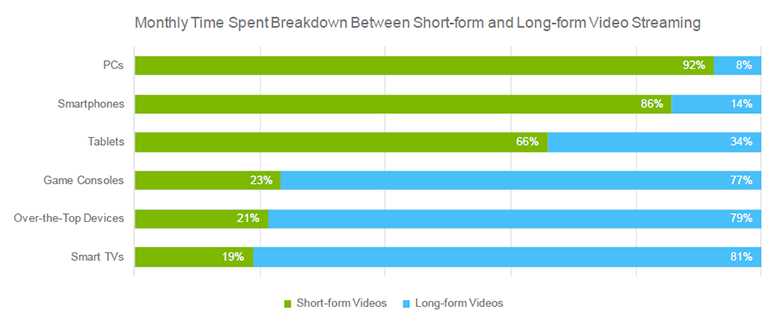
On PCs, long-form video use tends to peak in the early evening, but on smartphones and tablets it’s later in the evening. Although short-form video does peak, overall its usage is much more consistent during the whole day with any ‘peak’ only being slightly higher than the rest of the day.
It’s worth noting that long-form video consumption is much more dominated by a handful of core users than short-form: 10% of users account for 63% of long-form video sessions compared to 43% for short-form.
It’s also important to factor in simultaneous usage — ie, when two or more devices are used to view video and access another online service. The larger screen dominates for video consumption whenever there is simultaneous usage taking place. Consumers who simultaneously use a PC as well as a mobile device typically view the video content on the PC — the larger screen — rather than on a tablet or smartphone. The same applies to simultaneous use of a tablet and smartphone — the tablet is predominantly used for video consumption.
Online video consumer data divides into four key segments
Male consumption of video is far more dominated by short-form videos – accounting for 75% of their video time compared to just 55% among women. On a general level, short-form accounts for a greater share of video consumption as people get older, although 25-34s do buck this trend in that short-form accounts for a greater share of their time than it does among 18-24s.
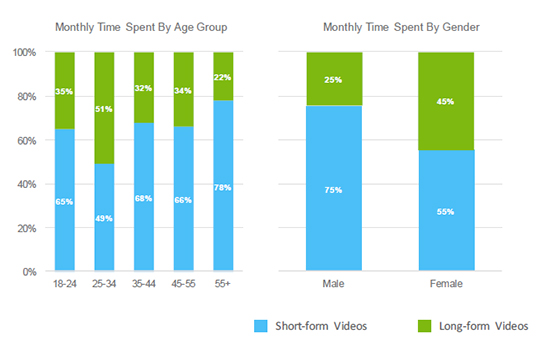
All the findings I’ve outlined so far have enabled us to identify four main personas for those who watch online video:
- Video Addict – they consume a lot of streaming video (over 11 hours a week) but typically do so on one device. Half of this group are aged 18-34.
- Screen Hopper – they don’t consume quite as much as the Addict (circa 9.5 hours weekly), but use multiple screens to do so. Like the Addicts, nearly half their audience is 18-34 but they’re nearly 8 times more likely to be university-educated.
- Technology Enthusiast – an average consumer of video content (just under 1.5 hours a week), but like the Hopper does it across many different devices. 18-34s account for one third of the group, who are the most likely to be university-educated (53%).
- Occasional User – consumes around 1.25 hours of online video weekly, but only does so on a single device such as a mobile or PC – not both. Only around 20% of this audience are 18-34, but they’re the most likely to be in households with a $100,000+ income (29%).
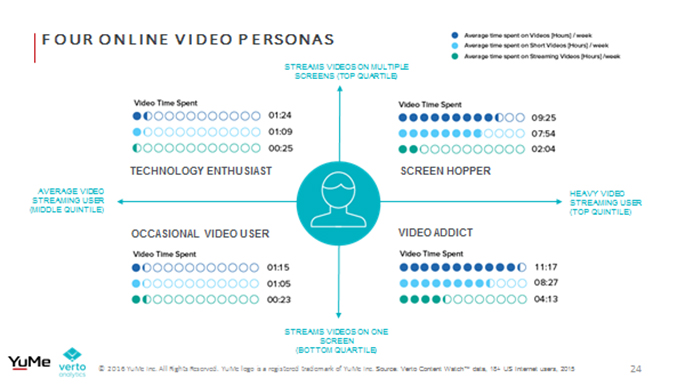
The chart below illustrates how understanding different personas enables you to more effectively target their behaviour. Across video viewing on a smartphone during a weekday, it reveals peak usage among the heaviest users – Screen Hoppers and Video Addicts – peaks around 9pm, whereas for Technology Enthusiasts it’s around 11am and for Occasional Users it’s 7pm.
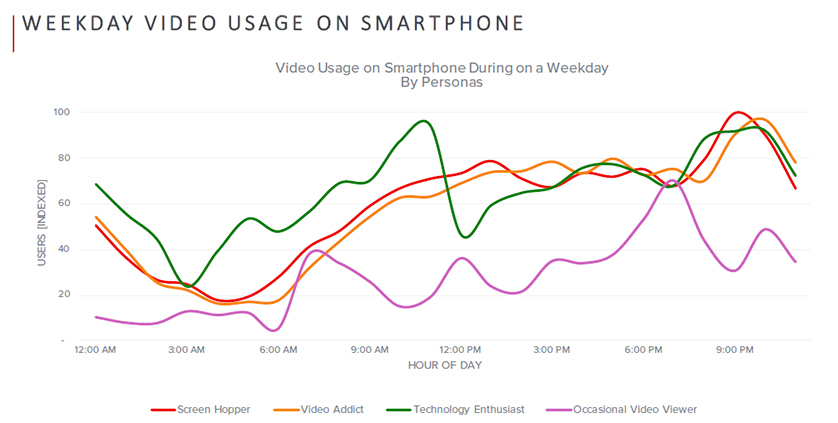
So, what does this all mean for you?
Based on these data and insights, here are my five key tips:
- Think heterogeneity. Don’t think about video advertising and video consumers as one big bucket – there are multiple practical and efficient ways to segment these consumers, which are vital to successfully planning and executing video ad campaigns and drive ROI. Video consumption varies by distinct personas across a number of dimensions and consumers are liquid in that they move from one device to another seamlessly, in nonlinear ways.
- Think genuine cross-device. To properly understand which device and video channel to use for your specific target group, you need to understand and use quantifiable cross-device audience metrics, preferably based on a single-source approach, to reliably and comprehensively understand the same consumer for your planning. Cobbling together different sources, using census data, or applying fusion models, do not work in properly understanding what the consumer is doing, and why. For example, if you see that a user uploads a scuba diving video on YouTube with his tablet, but you didn’t have access to his smartphone data that revealed that he is on holiday in the Maldives, you’re missing part of the story as a researcher.
- Think daypart. Different screens for video content and advertising channels work better at different times of the day, or different locations, don’t forget to think about your creatives and campaign parameters in light of this.
- Think new screens. Consumers are increasingly moving beyond the three primary connected devices by adding new ones, such as Smart TVs, to their viewing repertoire, sometimes replacing them. It’s vital to keep on top of these trends, particularly if you’re targeting quickly evolving young audiences.
- Negotiate smarter. When you negotiate with ad channels and video streaming publishers, use audience ratings data as the basis for your discussions – pay not only for reach, but also frequency and use metrics around advertising ROI in your negotiations to gain an upper hand in discussing what works for your advertising needs.
Read also:
The most effective uses of video marketing
Targeted video content ‘will be the cornerstone of all future marketing’











Leave your thoughts